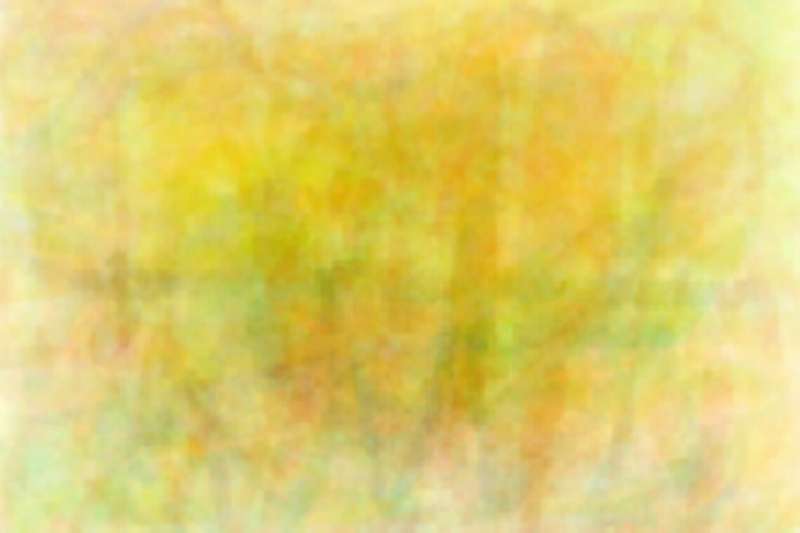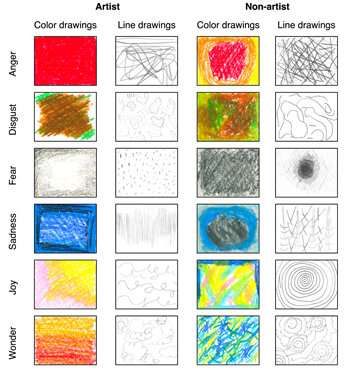This article has been reviewed according to Science X's editorial process and policies. Editors have highlighted the following attributes while ensuring the content's credibility:
fact-checked
peer-reviewed publication
trusted source
proofread
Researchers explore how people depict and perceive emotions through color and line in visual art

Are you feeling blue—or seeing red? Maybe turning green with envy? You're not alone in color-coding your emotions, University of Toronto researchers say in a new paper confirming associations between feelings and certain shades and shapes.
In a new study in the Journal of Vision, researchers from the Faculty of Arts & Science's department of psychology and their collaborators have confirmed research identifying consistent associations between certain colors and lines, and particular emotions.
In addition, they've shown that it is easier to predict the emotion being depicted with color drawings than line drawings; and that emotion predictions are more accurate for color drawings by non-artists than by artists.
"What we confirmed in our study was the systematic use of certain colors and lines to depict certain emotions," says Dirk Bernhardt-Walther, an associate professor in the department of psychology.
"For example, anger is depicted using red, or in drawings with densely packed lines. Sadness is blue and associated with vertical lines. We use these conventions to portray emotions—and observers perceive the emotions intended."
The findings could help designers and visual artists convey emotions to users or viewers, or create architectural or designed spaces that evoke positive responses. It could also lead to a better understanding of visual esthetics—how artists depict emotions in their work and whether it evokes the response they desire from viewers.
The study's lead author is Claudia Damiano, a postdoctoral researcher with the department of brain and cognition at KU Leuven in Belgium, and a former graduate student in Bernhardt-Walther's lab. Damiano conducted the research with Pinaki Gayen, a visiting graduate student who came to U of T's department of psychology in 2019 on a Shastri Indo-Canadian Institute Research Fellowship. U of T co-authors include Bernhardt-Walther and postdoctoral fellow Morteza Rezanejad, also in the department of psychology.
For the study, Bernhardt-Walther and his colleagues recruited 40 students from visual arts programs at OCAD University and 41 non-artists from STEM programs at U of T. All were instructed to create two abstract drawings—one using color and one lines—for each of six emotions: anger, disgust, fear, sadness, joy and wonder.
The researchers began by validating the idea that distinct emotions were depicted in a consistent manner. First, they conducted computational analysis of the lines and colors in all the drawings. They then built a computational model that could predict the emotion from the visual properties of drawings by artists and non-artists.
They found that drawings depicting negative emotions tended to contain more lines and darker colors: red, blue, brown, black and gray. Drawings of positive emotions were less dense, had more curved or oblique lines and contained brighter colors.

Images for joy were predominantly yellow-green, those depicting disgust were a darker green, anger was shown as red while sadness was blue, and so on. The line drawings exhibited different styles of lines—from strong, intersecting lines for anger, to wavy and curved lines for joy.
The team also compared how artists and non-artists conveyed emotions with colors and found that trained artists generally used a smaller number of colors than non-artists and that the colors they used were unconventional. They also discovered that non-artists were better at conveying emotions through color than artists.
"I believe the reason for this difference could be that non-artists tend to follow convention, whereas artists strive to be innovative—they want to do something distinctive," Bernhardt-Walther says. "Artists know what the conventions are but they want to break from those conventions in order to provoke, stand out and create something special."
The researchers also found that it is easier to guess the emotion a color drawing is portraying than in a line drawing. They speculate that this is because the associations between colors and emotions are stronger for people than those between lines and emotions.
And while the study did not delve into whether these associations are innate or learned, Bernhardt-Walther draws on his own research and that of other academics, noting these color-emotion matches aren't just culturally learned—in other words, we didn't learn them simply from the paintings, illustrations and movies viewed throughout our lives.
"There is generally very good agreement on the association between colors and emotions across cultures that have developed independently," Bernhardt-Walther says.
"There is consensus that red has significance because it is associated with blood—whether it's your prey's blood or your own. Our faces turn red when we are angry and gray or green when we feel nauseous. Darkness is scary because of the unknown danger.
"And in addition to being associated with sadness, blue is also calming—and the obvious association with the sky and water and being in the open where you are less at risk from a danger like a predator. We imitate these colors in artwork to specifically evoke these emotions."
For Bernhardt-Walther, the study is consistent with his growing interest in the effect of the visual environment on our emotions.
"I'm studying visual esthetics more and more now as part of my research," he says.
"I want to know what people find esthetically pleasing and why, because I think it is an integral part of our perceptual experience. Liking or disliking what we see is directly related to how we think and how we perceive the world."
More information: Claudia Damiano et al, Anger is red, sadness is blue: Emotion depictions in abstract visual art by artists and non-artists, Journal of Vision (2023). DOI: 10.1167/jov.23.4.1



















